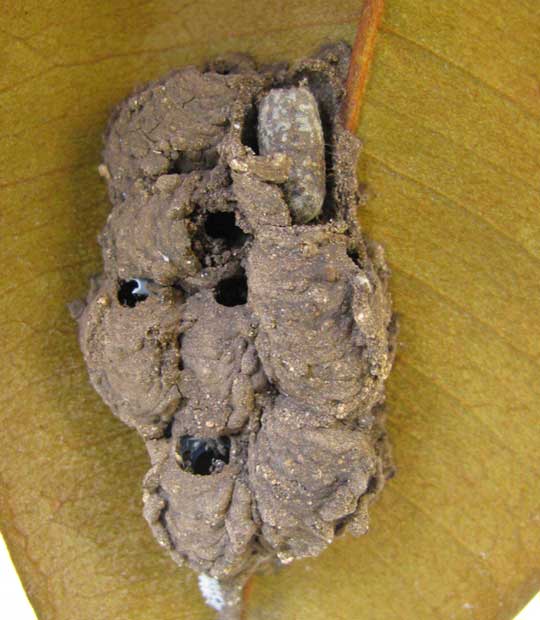Excerpts from Jim Conrad's
Naturalist Newsletter
from the March 6, 2011 Newsletter issued from Hacienda Chichen Resort beside Chichén Itzá Ruins, central Yucatán, MÉXICO; limestone bedrock, elevation ~39m (~128ft), ~N20.676°, ~W88.569°
POTTER WASP NESTS ON A LEAF
Also this week I happened to notice what's shown below:

Those pea-size insect nests are indeed nests made of mud stuck to the silky, golden-brown underside of a vertically hanging leaf of the Star-Apple tree outside Hacienda Chichen's public bathroom. The leaf hung at head level and someone had picked the top, right pot's mud walls away revealing the cocoon from which, apparently, an adult wasp already has emerged. A couple of the pots lack escape holes.
By comparing pictures of these "pot nests" with others on the Internet, I'm guessing that they belong to a species of potter wasp, genus EUMENES. Eight species of Eumenes wasp are known in North America and who knows how many exist in Mexico, and which species we have here?
Even Bea in Ontario couldn't come up with much guidance. She did run across some general advice for identifying wasp nests made of mud, which she interpreted as suggesting that nest identification is difficult even for the experts. Here's the advice:
"... search an empty cell for the remains of spiders (legs, etc). If there are spider remains it is one of the Auplopus (genus) spider wasps (family Pompilidae). Pollen residue would indicate this is the nest of an Osmia mason bee. Caterpillar remains would indicate a wasp in the Eumeninae subfamily of Vespidae."